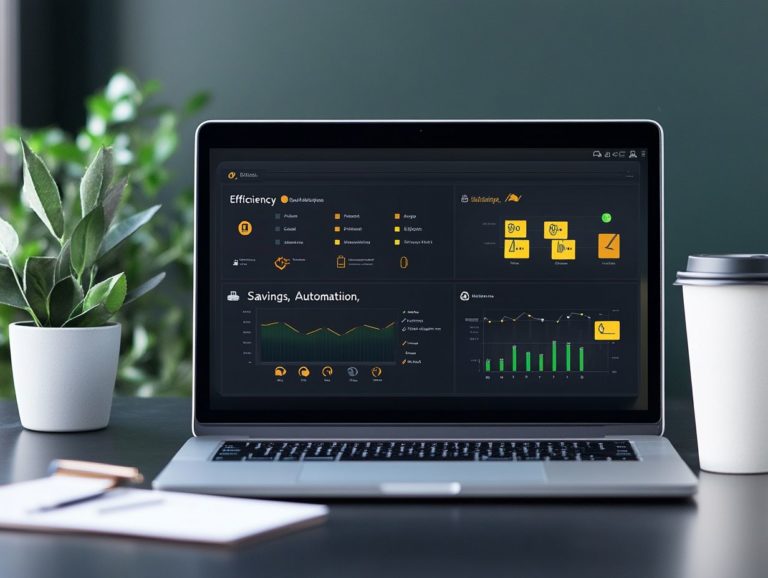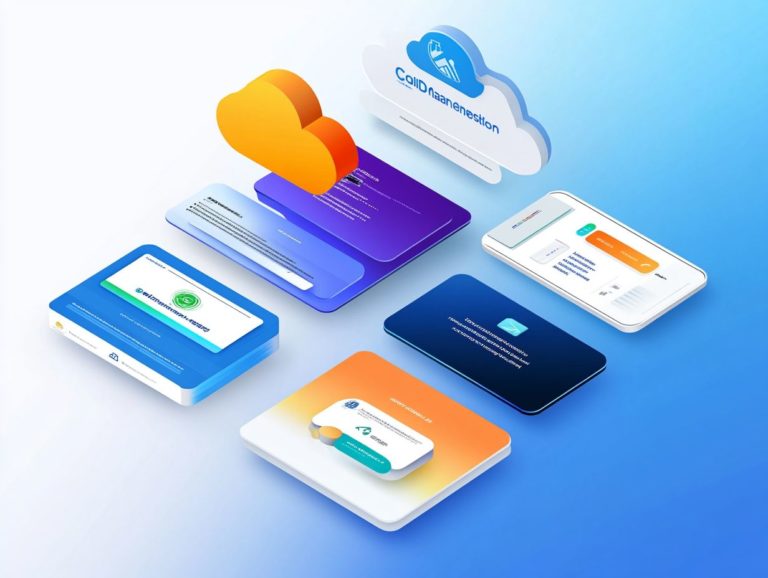Cloud Cost Management: A Comprehensive Review
In today s digital landscape, managing cloud costs effectively is more crucial than ever for you. As your business increasingly relies on cloud solutions, understanding cloud cost management can make all the difference between sustainable growth and wasted resources.
Let s explore what cloud cost management is and why it matters. This article will discuss its definition and significance, explore key factors influencing your expenses, and share best practices for optimization. You ll discover the top tools available, gain insights into common challenges, and look ahead to future trends that could reshape how you manage your cloud investments.
Join this journey to uncover strategies that will help you maximize your cloud budget and drive efficiency.
Contents
- Key Takeaways:
- Understanding Cloud Cost Management
- Factors Affecting Cloud Costs
- Best Practices for Cloud Cost Management
- Tools for Cloud Cost Management
- Challenges in Cloud Cost Management
- Future Trends in Cloud Cost Management
- Frequently Asked Questions
- What is Cloud Cost Management and why is it important?
- What are the key components of Cloud Cost Management?
- How does Cloud Cost Management help businesses save money?
- What are the common challenges in Cloud Cost Management?
- How can businesses ensure effective Cloud Cost Management?
- Are there any specific strategies for optimizing cloud costs?
Key Takeaways:

- Effective cloud cost management is crucial for businesses.
- It helps optimize spending and maximize return on investment.
- Factors such as usage, storage, and resource allocation greatly impact cloud costs.
- Careful monitoring and management are necessary.
- Using the right tools and strategies will help businesses face challenges and adapt to future trends.
Understanding Cloud Cost Management
Grasping the nuances of cloud cost management is essential for any enterprise harnessing cloud services. It involves a range of critical elements, including cost visibility, financial planning, and resource provisioning. Understanding the factors affecting cloud cost management can help optimize cloud expenditure and minimize waste.
As your business shifts towards cloud-based systems, implementing robust cost management practices becomes paramount. This approach will enable you to easily manage the complexities of enterprise cloud costs, ensuring that every dollar spent drives maximum value.
Definition and Importance
Cloud cost management encompasses the strategies and practices you employ to oversee your expenditures on cloud services. By adopting careful cloud cost management techniques, you can enhance operational efficiency and make informed resource allocation decisions.
Proper budgeting for cloud services allows you to track and forecast spending. This ensures that your financial resources are directed toward areas that yield the greatest returns. The benefits of careful financial planning extend far beyond simple cost savings; it plays a pivotal role in driving overall business profitability.
When you optimize your cloud spending, you position yourself to invest more strategically in innovation and development, ultimately strengthening your competitive edge in the marketplace.
Factors Affecting Cloud Costs
Several key factors influence cloud costs for enterprises, including your resource usage patterns, the cloud pricing models you choose, and any unexpected expenses that may arise during cloud adoption.
Key Variables to Consider
Consider these key variables in your cloud cost management: cost monitoring, adjusting resources to match what you actually need, and keeping track of cloud usage.
Effective cost monitoring is your foundational strategy. It allows you to track spending in real-time and helps you identify unnecessary expenditures, such as over-provisioned instances that are sitting idle.
Next, adjusting resources to match what you actually need requires analyzing usage patterns. This not only boosts performance but also minimizes waste.
Keeping track of cloud usage provides valuable insights into usage trends across departments. This enables more informed decision-making. By aggregating data from multiple sources, you can pinpoint inefficiencies and identify areas ripe for cost reduction.
By addressing these variables with targeted strategies, you can significantly enhance your cloud cost efficiency and drive substantial savings.
Best Practices for Cloud Cost Management

Implementing best practices in cloud cost management is essential for enterprises striving for effective cloud cost optimization and financial oversight, making it important to consider comparing cloud cost management tools.
By doing so, you ensure that your resources are utilized efficiently, leading to enhanced fiscal responsibility and strategic growth.
Effective Cost Optimization Strategies
Effective cost optimization strategies in cloud management help you use cloud performance metrics, resource provisioning, and AI-driven insights to pinpoint areas ripe for improvement.
By concentrating on these strategies, your organization can boost operational efficiency. You can also significantly cut down on unnecessary expenditures.
Adopting robust cloud governance practices is crucial for maintaining oversight. It ensures that resource utilization aligns seamlessly with your organizational goals.
Monitoring tools provide real-time visibility into spending patterns. This allows you to make proactive adjustments and respond promptly to any anomalies.
Conducting regular audits and employing automated scaling solutions can enhance your resource allocation.
Together, these components create a sustainable approach to cost management. This allows your company to scale effectively while minimizing financial waste.
Tools for Cloud Cost Management
You have access to a variety of sophisticated tools for cloud cost management. These tools are designed to help you optimize your cloud expenditure through intelligent resource management and insightful analysis.
These tools enable you to make informed decisions. They ensure that your investment in cloud services is both efficient and effective.
Top Software and Services
Top-tier software and services for cloud cost management are within your reach. Platforms like DRYiCE MyXalytics harness the power of machine learning (a method where computers learn from data) to deliver valuable insights into your cloud spending.
Not only does it meticulously track expenses, but it also provides predictive analytics. This enables your team to spot potential overspending before it becomes an issue.
Another standout solution is CloudHealth, celebrated for its robust governance features. It enables organizations to optimize their cloud resources with finesse.
Its distinctive dashboard offers real-time visibility into costs, usage, and performance. This allows you to make informed, data-driven decisions.
Similarly, Apptio Cloud Benchmarks helps you compare your cloud spending against industry standards. It tackles the common challenge of pinpointing inefficiencies.
By integrating these advanced tools, you can refine your cloud financial management processes. Ultimately, this enhances resource allocation and unlocks significant cost savings.
Challenges in Cloud Cost Management
You will encounter a multitude of challenges in cloud cost management. These include billing disputes, operational inefficiencies, and the looming risk of cloud waste.
Each of these factors can significantly impact your overall effectiveness and bottom line. It is essential to navigate them with precision and foresight.
Common Obstacles and How to Overcome Them

Common obstacles in cloud cost management include a lack of cost visibility, unexpected expenses, and ineffective governance. These challenges can place a significant financial burden on organizations, leading to budget overruns and the misallocation of resources.
Without clear visibility into cloud expenditures, you may find it difficult to pinpoint where your budget is being consumed. This often results in unnecessary spending.
Unexpected costs can emerge from unanticipated usage spikes or outdated pricing models. Ineffective governance might leave you without the necessary protocols and controls to manage your cloud resources efficiently.
By implementing robust monitoring tools, you can gain real-time insights into resource utilization. Cost allocation tags will help you track and analyze expenses more effectively.
Fostering a culture of accountability within your teams can greatly enhance governance. This ensures that everyone remains mindful of their cloud usage.
Future Trends in Cloud Cost Management
Future trends in cloud cost management will likely be shaped by advancements in technology. This is particularly true through AI-driven insights and strategic initiatives aimed at effective cloud cost optimization.
Embracing these innovations will enable you to manage expenses more efficiently. This will help maximize the value of your cloud investments.
Predictions and Potential Innovations
Predictions for the future of cloud cost management suggest a shift toward more sophisticated financial oversight and potential innovations in cloud-native architectures. As you increasingly rely on cloud services, learning how to conduct a cloud cost audit will become crucial for accurately predicting and managing expenses.
This environmental shift is poised to foster the creation of smart tools that analyze data, allowing you to gain real-time insights into resource utilization and costs. Consequently, your organization will enhance its cost-saving strategies and drive operational efficiency.
Get ready to embrace financial wisdom! Start training your teams and using automation to make the most of your cloud spending. By taking these proactive measures, you can maximize your cloud investments while minimizing unnecessary expenditures.
Frequently Asked Questions
What is Cloud Cost Management and why is it important?
Cloud Cost Management is the process of monitoring, analyzing, and optimizing the costs associated with using cloud services. It’s important because it allows organizations to control their cloud spending and avoid unexpected expenses, making understanding cloud cost management strategies essential for achieving significant cost savings.
What are the key components of Cloud Cost Management?

The key components of Cloud Cost Management include cost visibility, cost optimization, and cost governance. Cost visibility involves tracking and monitoring cloud spending, while cost optimization focuses on identifying and implementing cost-saving measures. Additionally, understanding cloud cost management regulations establishes policies and procedures to ensure effective use of cloud resources.
How does Cloud Cost Management help businesses save money?
Cloud Cost Management helps businesses save money by providing better visibility and control over their cloud spending. By optimizing resource usage and implementing cost-saving strategies, organizations can reduce their overall cloud expenses and avoid unnecessary costs, especially as we explore the future of cloud cost management.
What are the common challenges in Cloud Cost Management?
Common challenges in Cloud Cost Management include limited visibility into cloud spending, complex pricing models, and difficulties in predicting and managing costs. To address these issues, learning how to navigate cloud cost complexity is essential. Managing multiple cloud providers is also a challenge, along with the lack of cost optimization expertise.
How can businesses ensure effective Cloud Cost Management?
To ensure effective Cloud Cost Management, businesses should start by setting clear goals for their cloud spending. They should regularly monitor and analyze cloud costs, implement cost-saving measures, and establish governance policies. For more detailed strategies, learning how to implement cloud cost controls can enhance successful cost management, as well as utilizing cost management tools and collaborating with a dedicated cost management team.
Are there any specific strategies for optimizing cloud costs?
Yes, there are several strategies for optimizing cloud costs. These include adjusting the size of your cloud resources to fit your needs, using reserved instances, and leveraging spot instances for non-critical workloads. Additionally, implementing automated scaling and monitoring tools, optimizing storage usage, and regularly reviewing cloud resources can help reduce costs.






